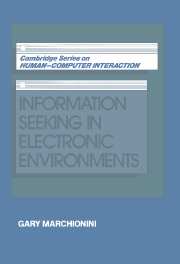Book contents
- Frontmatter
- Contents
- List of figures and tables
- Preface
- Acknowledgments
- 1 Information and information seeking
- 2 Information seekers and electronic environments
- 3 Information-seeking perspective and framework
- 4 Foundations for personal information infrastructures: Information-seeking knowledge, skills, and attitudes
- 5 Analytical search strategies
- 6 Browsing strategies
- 7 Designing support for browsing: A research and development perspective
- 8 The continuing evolution of information seeking
- 9 Future directions and conclusion
- Notes
- References
- Index
7 - Designing support for browsing: A research and development perspective
Published online by Cambridge University Press: 14 January 2010
- Frontmatter
- Contents
- List of figures and tables
- Preface
- Acknowledgments
- 1 Information and information seeking
- 2 Information seekers and electronic environments
- 3 Information-seeking perspective and framework
- 4 Foundations for personal information infrastructures: Information-seeking knowledge, skills, and attitudes
- 5 Analytical search strategies
- 6 Browsing strategies
- 7 Designing support for browsing: A research and development perspective
- 8 The continuing evolution of information seeking
- 9 Future directions and conclusion
- Notes
- References
- Index
Summary
Many things difficult to design provide easy performance.
Samuel Johnson, RasselasImagination is more important than knowledge.
Albert Einstein, On ScienceMany specific system features have been shown to invite and support browsing as an information-seeking strategy. We are beginning to acquire a set of techniques that define what is possible in designing such features. Determining what is optimal for different users, tasks, and settings requires systematically testing techniques across the range of information-seeking factors. Because browsing requires users to coordinate physical and mental activities, systems that support browsing must solve both technical and conceptual problems. Technical challenges such as the computational power needed to manipulate huge vector spaces on-the-fly and display problems such as resolution limitations, refresh and scroll rates, window sizes, and juxtapositions are difficult enough in isolation but must be coordinated with other technical problems such as mechanisms for selection and control of information and conceptual problems such as what the best representations of meaning are for specific information items and what should be displayed at what time, in what form, and at what level of granularity. Programs of research are needed that address the technical problems of designing interaction styles for browsing, that determine the physiological and psychological boundaries of browsing activities, and that test various representations for browsable information. These are technical, user, and organizational areas, respectively. Although different researchers and groups typically specialize in one of these problem areas, ultimately the support for browsing will depend on integrating results from all three.
Information
- Type
- Chapter
- Information
- Information Seeking in Electronic Environments , pp. 139 - 161Publisher: Cambridge University PressPrint publication year: 1995
